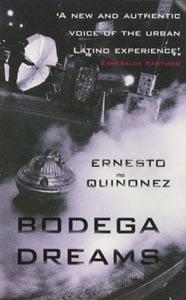Bodega Creative Writing
Chris Wiegand meets Ernesto Quiñonez and dives into Spanish Harlem with Bodega Dreams
With the short story collection Drown, Junot Diaz proved that modern literary representations of the Latin American experience could be both critically and commercially successful and Ernesto Quiñonez's assured debut novel Bodega Dreams follows suite. Published in the U.K. by Serpent's Tail, it has already gone down a storm in the States, earning Quiñonez the respect of acclaimed Latino authors such as Esmeralda Santiago.
Set in New York City's Spanish Harlem, Bodega Dreams centres around a charismatic former activist with the Young Lords in the 1960s named Willie Bodega. Young Lord turned drug lord in the '90s, Bodega idealistically plans to help out the people in his community by renovating the neighbourhood with profits from drug dealing. Bodega turns to Chino, the likable student who narrates the novel, to reach Vera, his one time lover from the '60s. Chino is at first suspicious of, and then sympathetic towards Bodega, but when his best friend Sapo is drawn deep into Bodega's web of crime things become more complicated and Chino's relationship with his wife Blanca is put under strain.
Ernesto Quiñonez grew up in Spanish Harlem himself and explains that the setting is one of the most important things for him about the novel: "It's basically a fact in the United States, that a lot of Latino issues go uncovered, especially in neighbourhoods like Spanish Harlem. They get totally ignored…I name a lot of places in the novel because I want the world to know that they exist. I wanted to show that this is a neighbourhood that is vibrant and a big cultural force in New York City.and that you can't keep ignoring us, we're part of the United States."

The neighbourhood that Qui̱onez presents in the novel is often a dangerous one, where the locals face a daily struggle for existence. Sapo remarks that "It's a Timex world" where "everyone takes a lickin' but you got to keep on tickin'." Opening with Chino's memories of school fights, Bodega Dreams is a hard-hitting novel in more ways than one. It is split into three books, the first two of which are told in a series of 'rounds' that each end with a knockout. Qui̱onez acknowledges that when he was growing up "it was always a fight Рespecially in the '70s and early '80s when New York City was bankrupt. If things broke then they stayed broken. And if you lived in a ghetto it was twice as bad. Since we couldn't take it out on Jimmy Carter or Ronald Reagan, we took it out on each other.That's why I made it a fight, because everyday was a struggle."
Quiñonez explains that he uses the plot of Jazz Age novel The Great Gatsby as a model for Bodega Dreams. At first glance, F. Scott Fitzgerald's 1925 tale of splendour and sophistication on New York's Long Island may seem like an unusual base for the story of a 1990s drug lord, but Quiñonez challenges this, saying that "When I see Gatsby, I see a poor guy who would do anything to become rich." He adds, "When rich people see Gatsby they think that he belongs to them, but Gatsby does not belong to the rich. Gatsby belongs to the poor. He was a hoodlum."
As a creative writing teacher, Qui̱onez encourages his students to use similar established literary frames as scaffolding for their own characters, claiming "all the stories have already been told" and that the most important thing is to make the story your own. The secret for this is the author's own literary voice, and one of the most immediately striking things about Bodega Dreams is the richness of the novel's language Рa mixture of various dialects, gritty urban American rhythms and what Qui̱onez calls "Spanglish." He describes Spanglish as "not two languages that chop each other up, but words that don't exist in either language."
The blend of languages in the novel is mirrored by the considerable range of Qui̱onez's literary influences. Each of its three books open with a quote from a Latino author and Qui̱onez proudly Рand often playfully Рwears a number of other influences on his sleeve, from J.D. Salinger to Walter Mosley, whom the author studied under at the New York City College Creative Writing Program. Qui̱onez uses the nature of Salinger's coming-of-age classic The Catcher In The Rye for the early part of the novel, and then employs the thriller elements of Mosley's mysteries for its later development. African-American writing in general has obviously had a considerable effect on the novel, from the James Baldwin-esque religious scenes to the Darwinian themes that recall Richard Wright's Native Son.
Quiñonez speaks with a compelling mixture of passion for the work of others and humility about his own first fiction, assuring me that he is "still learning the craft" of writing. Despite the critical acclaim that met Bodega Dreams, he still remembers the struggle of finding a publisher for the novel, which was rejected by fourteen different editors. This is hard to believe because Bodega Dreams is a lyrical and powerful triumph that promises great things for its author.
Source: https://spikemagazine.com/0201bodegadreams/
0 Response to "Bodega Creative Writing"
Post a Comment